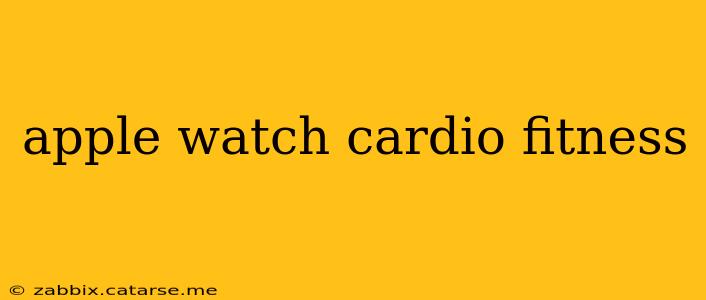The Apple Watch has revolutionized personal fitness tracking, offering a convenient and accurate way to monitor your cardiovascular health. Beyond simply counting steps, the Apple Watch provides detailed insights into your heart rate, workout intensity, and overall fitness levels, empowering you to make informed decisions about your health and well-being. This comprehensive guide will delve into the Apple Watch's cardio fitness capabilities, exploring its features, accuracy, and how best to utilize them for optimal results.
How Accurate is the Apple Watch for Cardio Tracking?
The accuracy of the Apple Watch for cardio tracking is a frequently asked question. While not a medical-grade device, the Apple Watch's heart rate sensor, combined with its sophisticated algorithms, provides a remarkably accurate picture of your cardiovascular activity. Its accuracy is influenced by factors like skin tone, placement of the watch, and individual variations in physiology. However, numerous studies and user experiences indicate a high degree of correlation between Apple Watch readings and those obtained from more established methods like EKGs, particularly for heart rate monitoring during exercise. For precise medical diagnoses, you should always consult a healthcare professional.
What Cardio Workouts Does the Apple Watch Track?
The Apple Watch seamlessly integrates with a wide array of workout types, providing comprehensive data for various cardio activities. From running and cycling to swimming (with the appropriate Apple Watch model) and high-intensity interval training (HIIT), the device intelligently recognizes and tracks key metrics like heart rate, calories burned, distance covered, and pace. You can manually select a workout type or let the device automatically detect your activity, providing maximum flexibility and ease of use. Furthermore, the watch encourages consistency through motivational features and personalized insights into your fitness progress.
Does the Apple Watch Measure VO2 Max?
Yes, the Apple Watch can estimate your VO2 Max, a crucial indicator of cardiovascular fitness. VO2 Max represents the maximum amount of oxygen your body can utilize during intense exercise. A higher VO2 Max generally indicates better cardiovascular health and endurance. The Apple Watch estimates VO2 Max by analyzing your heart rate, workout intensity, and other relevant data. While not as precise as laboratory measurements, the Apple Watch provides a useful and readily accessible way to track your VO2 Max over time, allowing you to monitor your progress and make adjustments to your training regimen.
How Does the Apple Watch Help Me Improve My Cardio Fitness?
The Apple Watch's fitness features go beyond simple data tracking. The device offers a powerful ecosystem of features designed to improve your cardio fitness. These include:
- Personalized workout recommendations: The Apple Watch suggests appropriate workout intensities and durations based on your fitness level and goals.
- Activity rings: The iconic activity rings visually represent your daily movement goals, motivating you to stay active throughout the day.
- Heart rate notifications: The watch alerts you to unusually high or low heart rates, helping to identify potential health concerns.
- Workout summaries: Detailed workout summaries provide insights into your progress, allowing you to identify areas for improvement.
- Integration with fitness apps: The Apple Watch seamlessly integrates with numerous third-party fitness apps, providing even greater customization and functionality.
Can the Apple Watch Detect Irregular Heart Rhythms (Afib)?
The Apple Watch incorporates a feature designed to detect atrial fibrillation (Afib), a common type of irregular heartbeat. Through irregular rhythm notifications, the watch can alert users to potential Afib episodes. However, it’s crucial to understand that this feature is not a substitute for a medical diagnosis. Any notification should prompt you to consult a healthcare professional for proper evaluation and diagnosis. The Apple Watch serves as a helpful screening tool, but a doctor's assessment is necessary for confirmation and appropriate medical management.
How Can I Get the Most Out of My Apple Watch for Cardio Fitness?
To maximize the benefits of your Apple Watch for cardio fitness, consider the following:
- Regular calibration: Ensure your Apple Watch's heart rate sensor is properly calibrated to ensure accurate readings.
- Proper watch placement: Wear the Apple Watch snugly but comfortably on your wrist for optimal sensor contact.
- Accurate workout selection: Choose the appropriate workout type for your activity to ensure accurate data collection.
- Consistent use: Track your workouts regularly to observe your progress and identify areas for improvement.
- Combine with other health measures: Consider incorporating other health measures, such as diet and sleep, for a holistic approach to wellness.
By leveraging the Apple Watch's capabilities and adopting a holistic approach to fitness, you can significantly enhance your cardiovascular health and overall well-being. Remember that while the Apple Watch provides valuable insights, it should be used in conjunction with professional medical advice when necessary.
